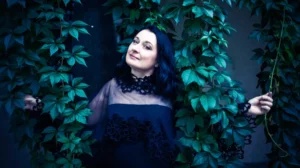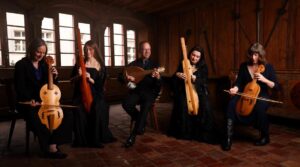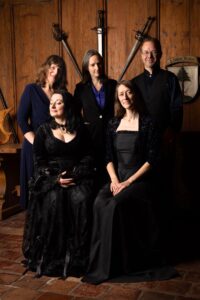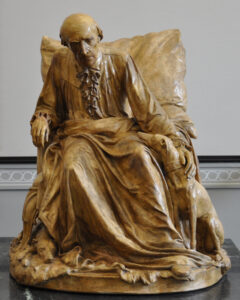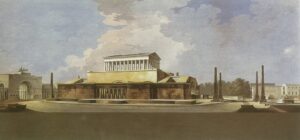Niespełna dwa tygodnie temu, a ściślej 22 grudnia, minęła 300. rocznica urodzin Karla Friedricha Abla. Z tej okazji, a także na dobry początek roku 2024 – roku wielkich nadziei, których nie pozwolimy nikomu popsuć – anonsuję płytę, o której walorach mogę śmiało Państwa zapewnić, i w której mam swój skromny udział w postaci eseju do książeczki: C. F. Abel / The Drexel Manuscript / Krzysztof Firlus (viola da gamba) / DUX 2027. Poniżej link do strony wytwórni. Miłej lektury, jeszcze milszego słuchania i jeszcze raz Szczęśliwego Nowego Roku.
***
Less than a fortnight ago, more precisely on 22 December, was the 300th anniversary of the birth of Carl Friedrich Abel. On this occasion, and to mark the beginning of 2024 – the year of great hopes that we will not allow anyone to spoil – I am announcing a CD, the value of which I fully vouch for, and in which I have my modest contribution in the form of an essay in the booklet: C. F. Abel / The Drexel Manuscript / Krzysztof Firlus (viola da gamba) / DUX 2027. Below is a link to the label’s website. Enjoy reading, enjoy listening even more, and once again, Happy New Year.
https://www.dux.pl/abel-the-drexel-manuscript-firlus.html
More at: www.krzysztoffirlus.com
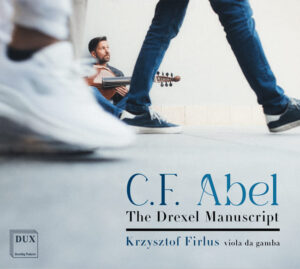
Gods did not like philanthropists. In the tragedy Prometheus Bound Aeschylus used the term philánthrōpos—the one who loves humanity—in the second scene of the exodos, when incensed Zeus, through his messenger Hermes, tries to convince the ‘fire thief’ to get rid of this love, which he considered a mockery of his divine honour. In vain, and it is hardly surprising. After all, Prometheus was the father of humans: he made them from clay mixed with tears and gave them the form of gods; although he created defective beings, of mean stature, weaker than titans, barely able to stand on their frail legs, whose bones cracked under the slightest weight, he still loved them. He smuggled them fire in a stalk of fennel, taught them to forge metal, farm, cook meals, read, write, and live in harmony with the forces of nature. Zeus was afraid of these creatures and therefore ordered to chain their creator to the rocks of the Caucasus.
Over time, the word philánthrōpos also appeared in Aristophanes’ comedies, Plato’s dialogues, and Xenophon’s speeches. The term was associated with a feature proper of true rebels—heroes fighting against gods and adversities for the good of their people; a feature attributed to rulers who care for the good of their subjects, characteristic of truly free people, concerned for the existence of every human being, including slaves deprived of legal and political personality.
Perhaps that is why the first modern philanthropists—among them William Wilberforce, member of the British Parliament from three different constituencies at the turn of the 19th century—were also zealously involved in the abolitionist movement. Back then, charity became a determinant of civic attitude, a virtue of moral people—well-mannered and free from vice. Some fought with weapons, while others carried the torch of enlightenment. Charity was no longer the sole domain of soft-hearted people. It was identified with a virtue that should be sought by all those aspiring to the elite opposing barbarity of culture. It also became a fashion; a remedy of wealthy burghers against the inefficiency of state administration; an alternative way to be remembered by descendants.
Even then not everyone was eager to go to war. Otherwise, it would be like in Stefan Żeromski’s novel entitled Ashes: ‘everyone would like to go across the Pilica River as quickly as possible, no one would like to work’. Francis Martin Drexel, born in 1792 in the Austrian town of Dornbirn near Bregenz, in Vorarlberg, historical land bordering Switzerland, definitely did not want to associate his future with the military. He was the eldest son of a wealthy merchant who skilfully took advantage of the privileges of Vorarlberg under the Habsburg rule. The lands of Vorarlberg had constituted a separate district since the 17th century, subject to the administration of goods in Tirol, and were under the administration of Western Austria only thirty years (from the middle of the 18th century). When little Francis was eleven, his father sent him to Italy so that the firstborn could at least learn the basics of Italian and French. The boy proved to be extremely talented—in two years he mastered as many as five foreign languages; in 1805, he returned to his hometown to learn a decent profession. He became an apprentice of a painter in a nearby village.
In the same year that Napoleon forced Vorarlberg and Tirol to join the Kingdom of Bavaria, Francis begged his father to help him avoid conscription. His father agreed to his request. The young man crossed the Rhine to get to Switzerland and holed himself up there for the next five years, making a living off of painting signs, renovating houses, and making custom portraits. In 1812, he secretly returned to Tirol. Before both countries were reunited with Austria, after the Vienna Congress, he had managed to get to Bern in Switzerland and enrolled in further painting lessons.
Three years after Napoleon’s abdication, in 1817, Francis went to the port of Amsterdam, bought a ticket for eighty dollars, and boarded the John of Baltimore. Two months later, he disembarked in Philadelphia. He quickly found a job as a drawing instructor at a girls’ school and made good money as a portraitist. After a family scandal involving his brother-in-law, however, he had to seek his fortune elsewhere. For several years, he travelled South America, where his painting talent was appreciated so highly that he triumphantly returned to Philadelphia and set up his own banking house. Drexel & Co. soon grew to become one of the most powerful banks in the United States of America.
The founder of the banking empire shared his wealth as Prometheus shared fire. Three times a week, he would welcome every pauper who knocked on his door. Together with his wife Emma, he distributed food, shoes, clothes, medicine, and money to those in need; the couple soon hired an assistant who visited the applicants at home, interviewed them, and, on this basis, issued them with special certificates entitling them to receive an allowance directly from the Drexels. Francis and Emma donated a substantial sum of $30,000 a year to charity at the time, paying rent for hundreds of families and financing the manufacture of clothing for the poor in one of Philadelphia’s monasteries.
Francis Martin Drexel died in a train crash in 1863. He had six children, including three sons who followed in his footsteps, tied their careers to the family bank, and continued their father’s philanthropic activities. Two of them, the eldest Francis Anthony and the youngest Joseph William, also inherited their father’s passion for art. Joseph turned out to be extremely musical too. He mastered several instruments, especially the violin. After moving to New York, not only did he support financially local musical institutions, but he also actively engaged in their activities (including as director of the Metropolitan Opera and chairperson of the New York Philharmonic Society). During his numerous trips around the world, he amassed a huge collection of instruments, and in 1858 he bought a collection of scores and books on music from the German immigrant Henry F. Albrecht, which gave a start to his own collection, twenty years later enlarged by invaluable manuscripts from collections of European connoisseurs.

Photo: Grzegorz Mart
The so-called Drexel Collection—donated by Joseph William in 1888, just before his death, to the Lenox Library, which together with the Astor collection gave rise to the existing New York Public Library—contains over six thousand priceless prints and musical manuscripts. It includes, among others, several unique sources for the history of the output of 17th-century English composers and a manuscript marked with the Drexel 5871 reference number, containing, in addition to seventeen sonatas by Arcangelo Corelli and an anonymous Presto in C major, twenty-nine pieces for viola da gamba by a German virtuoso of the instrument, Carl Friedrich Abel.
Abel, like Drexel, came from a family in which not only the profession, but also certain values were passed from generation to generation. His grandfather, Clamor Heinrich, an outstanding organist and violone master, was, among others, a court musician in Köthen, an instrumentalist of the Duke’s band in Hanover, and, finally, an Obermusicus in Bremen. His father, Christian Ferdinand, gained a reputation as one of the most excellent string musicians of his era. He managed to avoid serving in the Swedish army during the occupation of northern Germany by getting married. After moving to Köthen, he became friends with Johann Sebastian Bach, the successor of Kappelmeister Augustin Reinhard Stricker, who employed him in the court orchestra as a violinist and a viola da gamba player. Bach was godfather to his daughter Sophie-Charlotte and then took care of his son’s musical education at the Leipzig Thomasschule. In 1743, young Carl Friedrich Abel—on the recommendation of Bach—got a place in the court orchestra in Dresden. Fifteen years later, he left for London and soon became a court musician of Sophia Charlotte, German princess of Mecklenburg-Strelitz, newly crowned Queen of Great Britain. Shortly thereafter, he was joined by Johann Christian, the eleventh son of Johann Sebastian. The musicians’ cordial friendship resulted in the launch of Bach-Abel Concerts in 1764—the first subscription concerts in England, organised initially by retired Venetian singer Teresa Cornelys in her residence at Soho Square and then, until the death of Johann Christian in 1782, in the prestigious Hanover Square Rooms.
Abel outlived his friend, but he died younger, at the age of sixty-four—apparently because he enjoyed the pleasures of worldly life too much. He was a genuine life and soul of the party and revolved around the greatest artists of the era—among them Thomas Gainsborough, an excellent portraitist and landscape painter and a talented amateur violinist, probably the first owner of the manuscript of Abel’s works for viola da gamba, which, over time, fell into the hands of Joseph William Drexel.
Abel’s music is as pleasant to the ear as it is complicated to perform. In his music, the composer took full advantage of the possibilities of an instrument that was gradually going out of fashion while maintaining a reliable sense of form—both in free-form preludes and in more formal dances and rondos. He skilfully played with silence, intensifying in these short pieces the impression of a non-existent dialogue between several musical narrators. The richness of contrasts, concerning both dynamics and articulation, sometimes brings to mind Mozart’s early symphonies, but on the other hand, it takes the listener back into the past, into the world of unexpected sound solutions from the works of Monsieur de Sainte-Colombe or Marin Marais.
Carl Friedrich Abel fell into oblivion for more than two centuries like many other composers, adored while alive and cast into the shadows shortly after their death. Had it not been for Drexel’s passion for collecting and a quite unexpected discovery of manuscripts in the Lower Silesian Maltzan palace in Milicz, Abel would have probably remained as enigmatic as one wealthy merchant from Vorarlberg, the father of Francis Martin, who decided to protect his offspring from the cruelty of war, thus inadvertently contributing not only to the development of banking and philanthropy, but also to the consolidation of artistic passion in his descendants.
***

Photo: Grzegorz Mart
Krzysztof Firlus plays a bass viola da gamba from the studio of Igor Przybyła—a copy of a seven-string instrument from 1693, by Michel Colichon, one of the most eminent Parisian luthiers of the late 17th century. Colichon’s gambas referred to the English model in terms of their structure—they had a slightly smaller body than their German counterparts but had a balanced sound despite shorter strings, and thus weaker tension. The top plate of the 2009 copy was made of spruce, while the back, ribs, and neck—of maple.
Carl Friedrich Abel used various instruments—in the portrait by the aforementioned Thomas Gainsborough, he plays a similar seven-string viol, although probably of German origin. However, it is also known that one of his favourite instruments was a six-string viol from the workshop of the Königsberg luthier Joachim Tielke (currently kept in the collection of the London Victoria & Albert Museum). This does not change the fact that none of the compositions preserved in the Drexel 5871 manuscript requires the use of a seventh string—which would confirm the thesis of most researchers that the aforementioned pieces were composed with a six-string viol in mind. Firlus’ choice is a kind of compromise between a still unattainable copy of the Tielke instrument and a reproduction of the French Colichon instrument, which allows to reflect all the nuances of these compositions.
Translated by: Żaneta Pniewska

